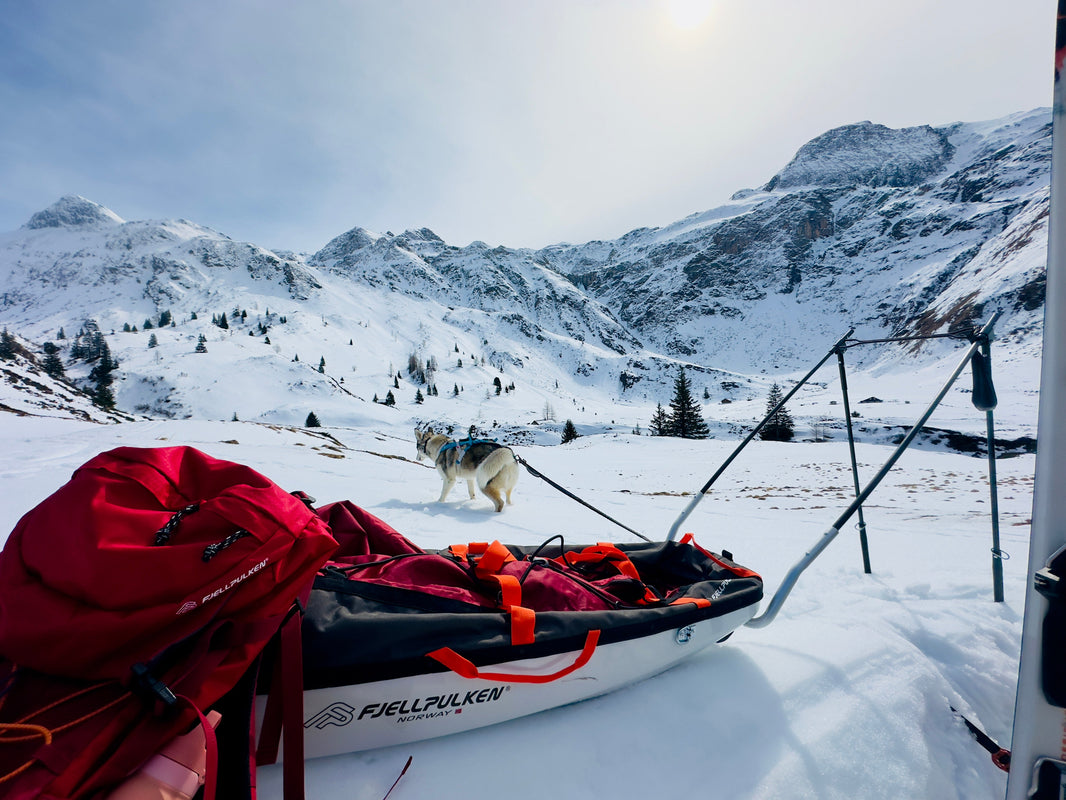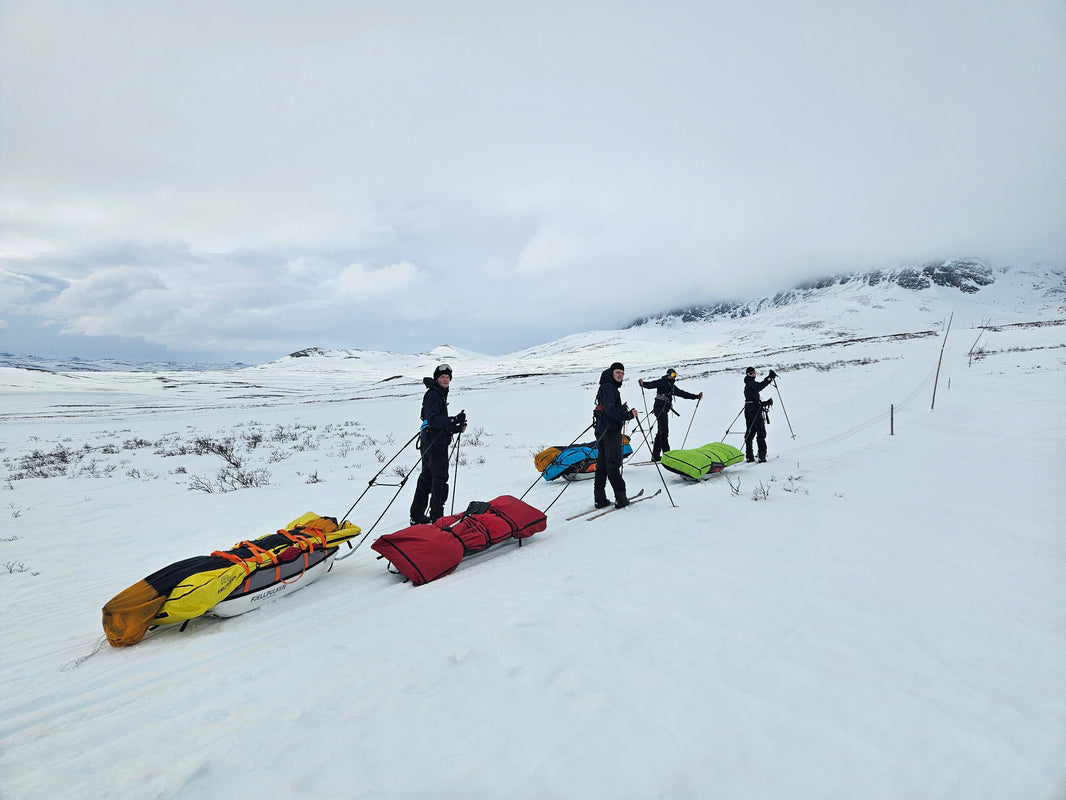In my last blog article, I shared some reflections from my first ski adventure on the Kungsleden – a journey full of beauty, lessons, and, admittedly, a few mistakes. In March 2026, I’ll return to Swedish Lapland for another ten days on skis with my husky Ylvi and a Fjellpulken pulka – this time, better prepared. Part of that preparation is seeking advice from those who truly know what life on the trail demands. So, I reached out to someone who has spent more than half her life in polar landscapes: Kathinka Gyllenhammar.
When I spoke with Kathinka, she was in her final preparations for her South Pole expedition in November 2025 – a “mother–daughter journey” that will make her and her 21-year-old daughter Emma the first duo of their kind to ski the roughly 700 miles to the Pole. Despite her tight schedule, Kathinka took the time to share her pragmatic wisdom, calm confidence, and years of experience living and traveling in the cold. She’s laid back, open, grounded, and refreshingly honest – someone who talks about pulling a 90-kilo sled with the same matter-of-fact tone others use when describing their daily commute or walking the dog in the neighbourhood.
Kathinka is a certified IPGA Polar Guide, working as a polar coach and expedition leader for Ousland Explorers. She’s guided and crossed some of the most remote places on Earth – from Greenland and Svalbard to the Antarctic Plateau – and spends around 150 nights a year sleeping outdoors. As she puts it: “You have to sleep well when you live outside. I always bring a sleeping bag that’s a bit too warm, because I really don’t like to be cold.”

The Pulka – Choosing the right Setup
When we discussed my own upcoming ten-day trip on the Kungsleden with my husky Ylvi and an occasionally bought Fjellpulken Tour 125 and the Fjellpulken Backpack, I asked her if my setup was sufficient. Her answer was clear: “The pulka should be big enough – but not too big. Otherwise, you’ll just fill it with things you don’t need.” For a solo trip over 10 days with a dog and tent, she explaines that my setup would be too small and recommends the Expedition Traverse 165: “It’s wider and more stable, and you can pack items crosswise. That gives you more opportunity to store your gear. Heavy gear such as food and tools should go in the back half, lighter things like spare clothes towards the front.”
Her approach to harnessing also surprised me. While I’ve been using a shaft system so far, Kathinka prefers the rope-pull setup. “On expeditions, we focus on preserving energy and never walk back. That’s a golden rule. The rope system lets you move efficiently and gives more flexibility. You just pull on the rope to bring the pulka towards you, you don’t have to walk back to it. But it requires practice. On steeper or tilted terrain, a shaft brings more stability. Try both and see what works for you.”
She describes her technique when descending steep hills: “With a rope, I keep the pulka beside me, like a dog on a short leash. Ylvi would be in front on a long line, and the pulka right next to you. It’s the way to control your heavy load. Additionally, you can attach a rope with knots in the front of the pulka – just in case it gets too fast, let the rope run underneath the pulka and it is slowed down.” Another detail she relies on: “Always secure your Sleeper to the pulka with a carabiner. When you open the sled to grab the tent, a gust of wind could easily blow the Sleeper away.”

Smart Packing & Everyday Efficiency
Kathinka’s system is designed for simplicity and access. “Never pack the pulka in two layers,” she says. “Only one layer of gear on the bottom of the pulka – otherwise you’ll take too much and the load gets too high.” Her tent goes on top in the Tent Bag, fastened with bungee straps, followed by the Sleeper secured with the standard straps. “Make sure you don’t cover any zippers you want to have access to later,” she reminds.
She keeps snacks in the middle pocket of the Sleeper – her personal “snack bag.” There she stores chocolate, nuts, dried fruit, and a Norwegian favourite: “It’s called Lefse – a soft, thin flatbread with cinnamon butter. It’s sweet, it’s sticky, and it’s the best thing when it’s cold because it does not freeze.” Her rule: “Everything that freezes must be pre-broken into small pieces – once it’s frozen, you’ll have a hard time getting it into bite-sized pieces.”
On longer expeditions, she easily eats 200–250 grams of chocolate a day. She laughs: “That is one good thing about being out in the cold. You can eat all the sweet stuff you would not eat at home.” For dinner, she relies on freeze-dried meals to save weight. “I love the Real Turmat Reindeer Stew. But when I’m just out for short trips near home, I bring real food – bread, butter cheese, thick salami. Simple, but it tastes amazing outside.”
Clothing and Layering
When it comes to clothing, Kathinka keeps things surprisingly minimal. „Pulling a pulka warms your body. I only wear a hard-shell Gore-Tex outer layer and a mesh base layer underneath. It really looks like being caught in a fishing net,” she laughs. The mesh underwear, made by the Norwegian company Brynje, creates small air pockets that trap the warm air released by the body while drying quickly at the same time. “It’s light, breathable, and incredibly efficient,” she says. Only when temperatures drop significantly does she add a down vest or a down skirt over her shell. And as soon as she stops moving, she immediately puts on a thick insulating jacket to keep warm.

Sleep System & Cooking Setup
Her sleep setup is straightforward but refined through years of trial: “A solid sleeping mat, a second insulating mat on top, and then a sleeping bag that’s too warm rather than too cold.”
Depending on the trip, she sometimes combines two sleeping bags – down on the inside, synthetic on the outside – to keep the down dry. The whole sleeping setup is stowed away in the Fjellpulken Sleeper. So, she has easy access to it as soon as the tent is set up. “And it is also a warm and cozy resting place for a short stop on the way,” she says.
For cooking, she advises me to rely only on liquid fuel stoves. “Propane simply doesn’t work in those temperatures,” she says. On self-supported expeditions, her pulka easily weighs 50 kilos, while on her upcoming South Pole expedition with Emma, they will pull 80 to 90 kilos each.
Training & Mindset
Her philosophy on training is beautifully simple: “Start low, like a diesel train – and then you can go forever.” Kathinka doesn’t go to the gym. “I live an active life outdoors for decades now, and sometimes I pull tires if I have the time,” she says. Emma trains more specifically, adding climbing and regular tire pulling. But the most important preparation, she emphasizes, isn’t physical: “It’s the mindset. Once you start your journey, there are no more problems – only challenges, or solutions you haven’t found yet.”
Final Advice for aspiring Polar Travelers
Before we ended our call, Kathinka had one last tip for anyone dreaming of winter expeditions: “Get proper training before you go. At Ousland Explorers, we run Polar Training Courses – long weekends where you learn everything about winter camping, equipment, and mindset. It’s the perfect foundation before heading out on your own.”
And perhaps the biggest takeaway from our talk: experience isn’t about perfection – it’s about adapting, learning, and keeping your sense of humor in the cold. Because as Kathinka says with a knowing smile, “Once you get used to the rope system, you’ll never go back.”
Text: Edith Danzer – Outdoor journalist and photographer preparing for her second Kungsleden adventure with husky Ylvi and Fjellpulken, March 2026.
Follow Kathinka and Emma on their one-of-a-kind expedition – Instagram miniogmuttern







